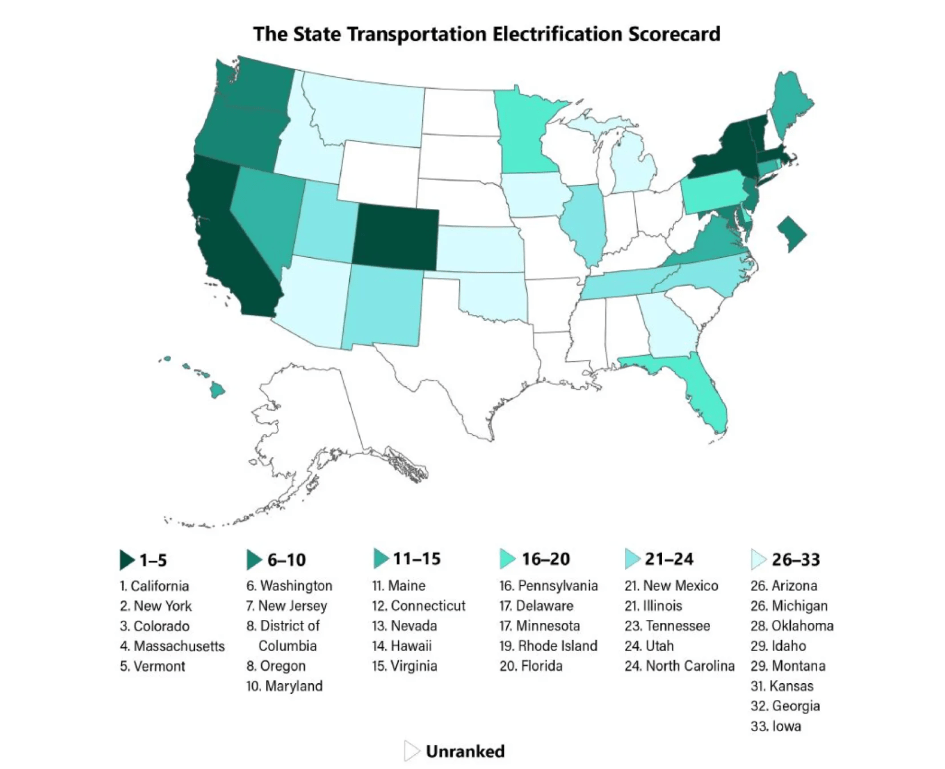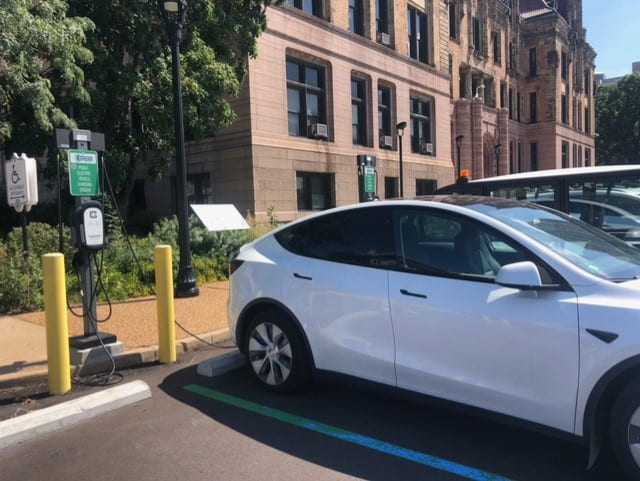
By Kyle Jacobs, class of ’24 Washington University
The transportation sector accounts for nearly 30% of emissions in the United States making it the largest GHG emitting sector in the United States. In light of this the American Council for an Energy Efficient Economy (ACEEE) has published two scorecards: one in 2021 and one just recently in June of 2023. These scorecards rank how effective states have been in promoting electric vehicles and reducing greenhouse gas emissions from transportation. The 310 page report was not only impressive in the sheer depth regarding EV policies, but also in its commitment to highlight how money is allocated and policy is shifting to low-income and minority communities.
Only the top 33 states were ranked as there was little differentiation between the bottom 17 states in overall performance. Unsurprisingly, California won convincingly with an overall score of 88 out of 100 points largely thanks to its Advanced Clean Cars II (ACC II), which mandates that all vehicles sold in the state be zero emissions by 2035, and Advanced Clean Trucks (ACT), which sets required targets for sales of zero-emissions heavy-duty vehicles.
Of the Midwest States only five actually ended up making it onto the top 33 list. Minnesota was our regional standout in both 2021 and 2023 championing a strong grid optimization strategy in addition to rigid GHG-reduction goals for the transportation sector specifically. Below I pieced together a bit of a highlight reel of what some of the ranked midwest states (and some unranked) are doing to maybe provide some inspiration for our other midwest friends. If we continue hammering away at these policies we could see all the midwest making the list! Maybe even crack the top 10 next time around!
17. Minnesota
Minnesota stood at the top of the pyramid when it came to Midwest Electric Vehicle policy. The state excels at policies that support grid optimization for electric vehicles. Incredible amounts of data have been collected around the state and from consumers to optimize the amount of power being outputted at certain times of day to keep the whole power grid intact while providing the perfect amount of energy to electric vehicles. Time-varying L2 (level 2 charging common in homes, workplace and public charging station) charging rates and DCFC-specific (direct current fast charging offers rapid charging in high congestion areas at designated stations) rates speak to Minnesota’s advanced system. The state also has very significant EV infrastructure investments with over $325 million. This makes it the third largest utility spending pot per capita in the U.S. Utility investments also go to support economically and environmentally distressed communities. Forty percent of the total investment will be focused in disadvantaged communities by providing access and increasing benefits. Minnesota also has GHG-reduction goals specific to the transportation sector including several clean car standards. The state continues to express the importance of interoperability, basically any electric vehicle can be charged anywhere regardless of brand or type. Open point protocol and open operated demand response will help control the amount of electricity flowing at any given point so it doesn’t burn-out the grid.
21. Illinois
Illinois is actually quite good about their electric vehicle purchase and charging incentives. The state EPA offers rebates that may cover up to 80% of the cost for installing and maintaining level 2 chargers. Additional rebates are given to those chargers being installed in economically and environmentally stressed communities. Similarly the DCFC chargers also receive a large subsidy for installation and maintenance. Although Illinois GHG-specific transportation goals aren’t as aggressive as some other states, just having that on their emission reduction plans already is a step in the right direction. One specific highlight is planning to have an all electric bus-fleet by 2040. Additionally they will reimburse any qualifying school district for any costs associated with transitioning to more fuel-efficient engines.
26. Michigan
Michigan mandated zero-emission transit-bus procurement target for transit agencies. Michigan helped reduce some of the barriers to entry parallel to this mandate in hopes to make EV adoption slightly easier for these agencies. Michigan was one of only eight states to receive full points in the category labeled, “Transit Agency Bus Goals and Procurement.” Additionally Michigan furthered its EV charger placement plan, collecting more data and optimizing the location of chargers in high-density areas. They made grants available for the installation of DCFC chargers that would cover ⅓ of the cost of installation up to $70,000. By 2035, the State of Michigan plans to have a zero-emission light-duty vehicle fleet and by 2045, the State of Michigan plans to have a zero-emission medium- and heavy-duty vehicle fleet.
31. Kansas
The KCPL (Kansas City Power and Light) Clean Charge Network Project was tasked with installing nearly 300 L2 chargers around the state of Kansas. In 2021 the same organization was approved to offer $500 rebates on certain commercial charger installations.
33. Iowa
In one metric discussing EV fees, States were evaluated by comparing their EV fees with the amount of gasoline tax revenue collected for the average internal combustion vehicle. Of the states that actually do enforce an EV fee, Iowa was the only state to receive full marks in this category having a very fair EV fee comparative to natural gas tax. Iowa has also shown some economic support for electric vehicle infrastructure.
Other Midwestern State Highlights
In 2015 Indiana spent $4 million to support EV car-sharing. In Missouri Ameren (investor-owned utility serving the St. Louis region and surrounding areas) spent $6 million in 2019 to support charging stations and provide rebates for EV’s and even provided a 10% carveout for low-income communities. Although North Dakota did not make the cutoff for the top 33, it earned a perfect score for its heavy-duty EV financial incentives. The state’s Department of Environmental Quality (NDDEQ) offers grants that cover up to 38% or up to 50% of upfront costs (for non government and government projects, respectively) for initiatives that replace or repower medium- and heavy-duty vehicles with new all-electric or hybrid vehicles. That being said, North Dakota has imposed EV fees and also didn’t allocate any money towards zero-emission buses with the Federal Transit Administration’s Low-No grant program.

Resources
If you want to view the full scorecard take a look here: ACEEE Scorecard.
There is also a webinar that helps breakdown some of the scorecard that you may find useful: Webinar